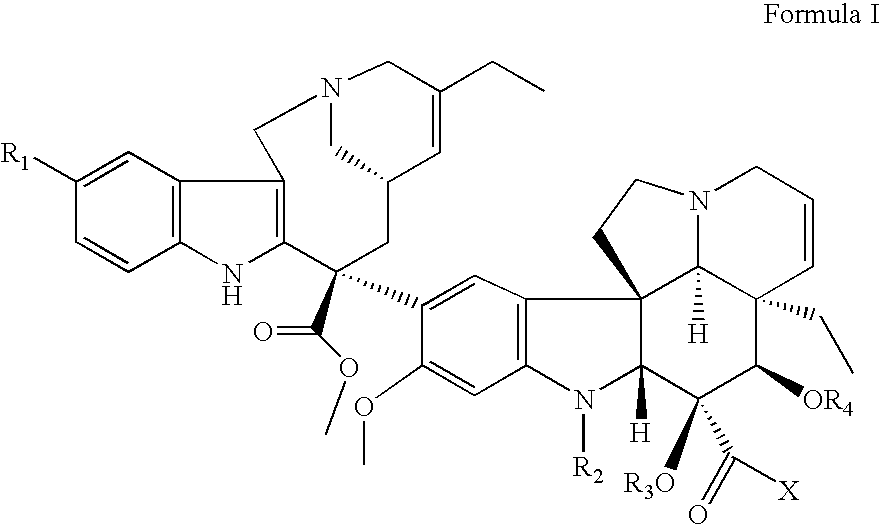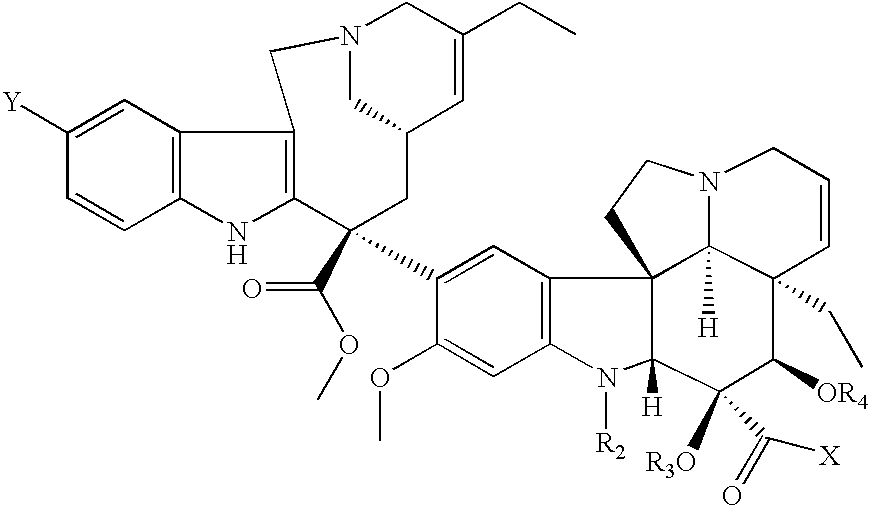Vinorelbine derivatives
a technology of vinorelbine and derivatives, which is applied in the direction of heterocyclic compound active ingredients, biocide, drug compositions, etc., can solve the problems of tumor formation, uncontrolled cellular proliferation, and tumor formation, and interfere with the dynamics of microtubule formation
- Summary
- Abstract
- Description
- Claims
- Application Information
AI Technical Summary
Benefits of technology
Problems solved by technology
Method used
Image
Examples
example 1
Preparation of 11′-Bromovinorelbine
[0222]A solution of N-iodosuccinimide (288 mg, 1.28 mmol) in trifluoroacetic acid / methylene chloride (1:1, 40 mL) was cooled to approximately 0° C. in an ice water jacketed addition funnel then added dropwise to vinorelbine tartrate (1.35 g, 1.28 mmol) in trifluoroacetic acid / methylene chloride (1:1, 60 mL) at −15° C. The temperature was monitored by an internal thermometer and maintained at −15±3° C. during the course of the addition (45 min). After stirring for 0.5 h, additional N-iodosuccinamide (15 mg, 0.067 mmol) in trifluoroacetic acid / methylene chloride (1:1, 5 mL at 0° C. was added dropwise to drive the reaction to completion. The reaction mixture was then poured carefully into a rapidly stirring mixture of 10% sodium sulfite / chloroform / saturated sodium hydrogencarbonate (1:1:2, 400 mL). Solid sodium hydrogencarbonate was then added in small portions until gas evolution stopped. The solution was then extracted with choroform (3×100 mL) and ...
example 2
Preparation of 11′-Iodovinorelbine
[0223]To an ice cold solution of vinorelbine ditartrate (0.084 g, 0.286 mmol) in trifluoroacetic acid (6 mL) under nitrogen was added a solution of N-iodosuccinimide (0.084 g, 0.365 mmol) in trifluoroacetic acid (3 mL) dropwise and the mixture was stirred at 0° C. for 1.25 hours. The reaction was quenched by the dropwise addition of saturated NaHCO3 and the mixture extracted with dichloromethane. The organic layer was washed with saturated NaHCO3, dried with Na2SO4, filtered and concentrated under reduced pressure. Purification by flash chromatography (silica gel, chloroform to 25% methanol in acetone) gave 11′-iodovinorelbine (220 mg, 85%). 1H NMR (500 MHz, CD3OD) δ 8.06 (d, J=1 Hz, 1H), 7.40 (dd, J=9, 1 Hz, 1H), 7.16 (dd, J=9 Hz, 1H), 6.31 (s, 1H), 6.25 (s, 1H), 5.84 (dd, J=10, 4 Hz, 1H), 5.74 (br, 1H), 5.45 (s, 1H), 5.30 (s, 1H), 5.26 (d, J=10 Hz, 1H), 4.31 (d, J=13 Hz, 1H), 4.23 (d, J=13 Hz, 1H), 3.85 (s, 3H), 3.76 (s, 3H), 3.73 (s, 3H), 3.65 (d...
example 3
Preparation of 11′-Vinylvinorelbine
[0224]A solution of 11′-iodovinorelbine (45 mg, 0.050 mmol) in DME (0.5 mL) and water (0.2 mL) was deoxygenated with argon for 3 minutes. The reaction vessel was charged with 2,4,6-trivinylcyclotriboroxane pyridine complex (13 mg, 0.055 mmol), Pd(PPh3)4 (7.5 mg, 0.070 mmol), and K2CO3 (7.6 mg, 0.055 mmol) and the mixture was heated to 80-90° C. After 2 h, the reaction appeared complete by ESI mass spectral analysis. The reaction mixture was diluted with saturated NaHCO3 (8 mL) and extracted with EtOAc (2×2 mL). The combined extracts were dried (Na2SO4) and concentrated to a brown solid which was purified by flash chromatography (silica gel, [CHCl3 / MeOH / NH4OH (40:18:2)] / CH2Cl2, 1:99 to 10:90) to yield 11′-vinylvinorelbine (15 mg, 31%) as a white solid: 1H NMR (500 MHz, CD3OD) δ 10.23 (br s, 1H), 7.73 (s, 1H), 7.34 (s, 1H), 6.82 (dd, J=17.5, 11 Hz, 1H), 6.61 (s, 1H), 6.41 (s, 1H), 5.94-5.91 (m, 1H), 5.87-5.86 (m, 1H), 5.74-5.70 (m, 1H), 5.63 (d, J=10...
PUM
 Login to View More
Login to View More Abstract
Description
Claims
Application Information
 Login to View More
Login to View More - R&D
- Intellectual Property
- Life Sciences
- Materials
- Tech Scout
- Unparalleled Data Quality
- Higher Quality Content
- 60% Fewer Hallucinations
Browse by: Latest US Patents, China's latest patents, Technical Efficacy Thesaurus, Application Domain, Technology Topic, Popular Technical Reports.
© 2025 PatSnap. All rights reserved.Legal|Privacy policy|Modern Slavery Act Transparency Statement|Sitemap|About US| Contact US: help@patsnap.com



